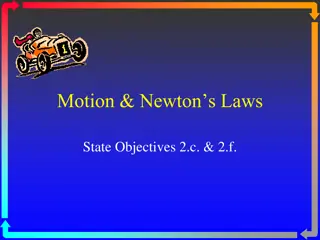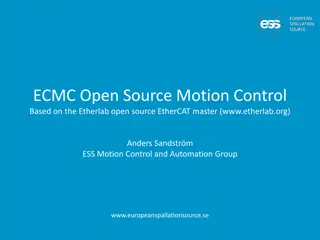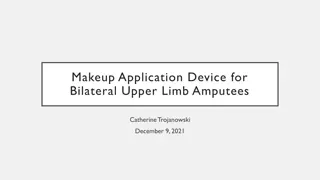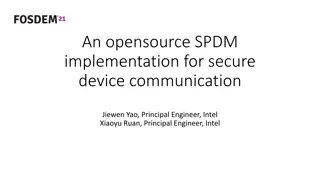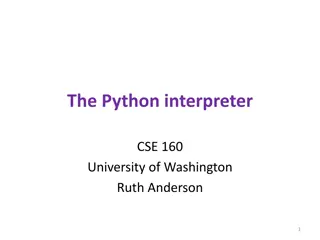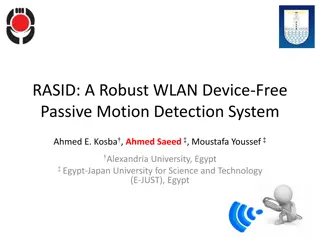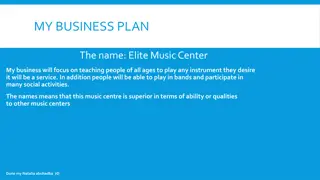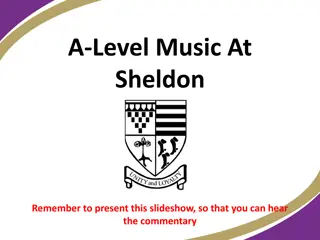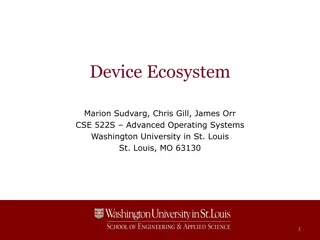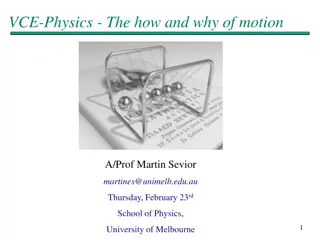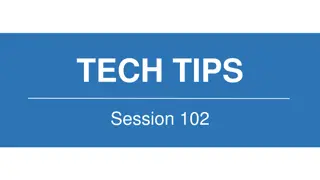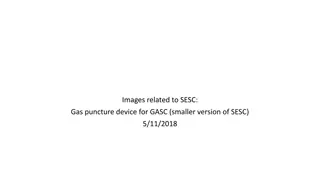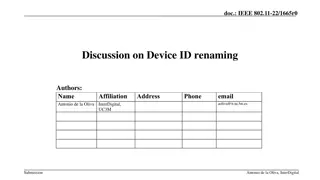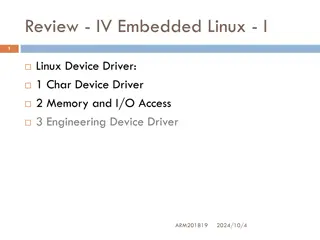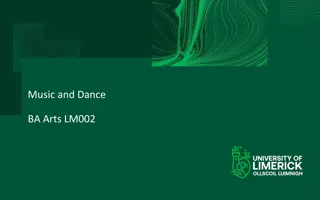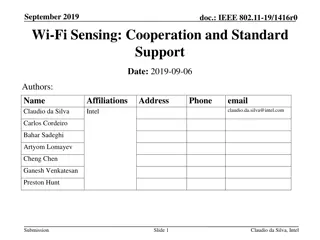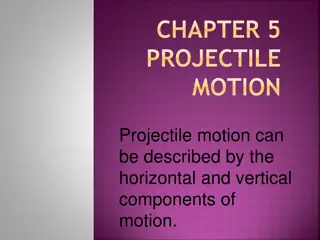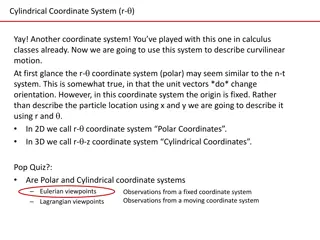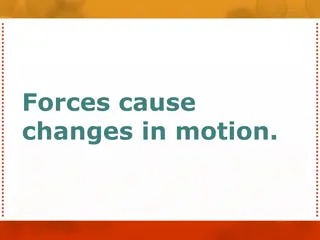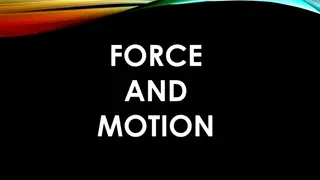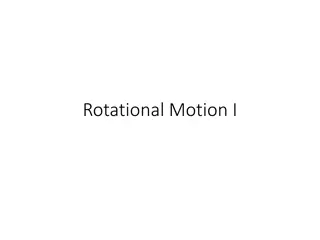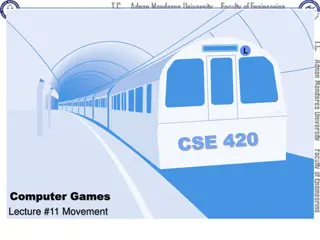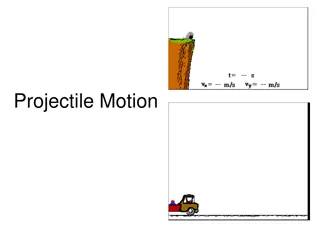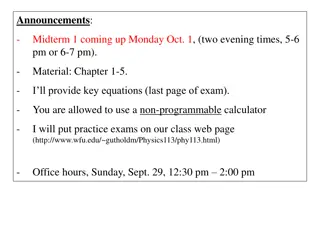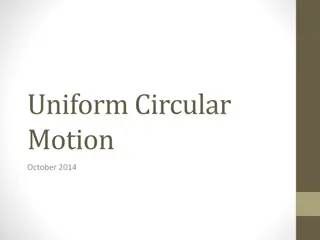Music in Motion: Innovative Running Device for Synchronized Music Experience
"Music in Motion is a cutting-edge running device that generates music synchronized to your exercise, matching your run tempo. With a digital control system, it syncs music to your footfalls and tracks milestones via an Android application. Project aims include biofeedback music control systems and a reactive audio environment tailored to the user's metrics. Device specs, including accelerometer and GPS integration, ensure a lightweight, customizable, and intuitive design for an enhanced workout experience."
Download Presentation

Please find below an Image/Link to download the presentation.
The content on the website is provided AS IS for your information and personal use only. It may not be sold, licensed, or shared on other websites without obtaining consent from the author. Download presentation by click this link. If you encounter any issues during the download, it is possible that the publisher has removed the file from their server.
E N D
Presentation Transcript
What is Music in Motion? Running device that generates music while you exercise Music matches your run Digital control system synchronizes the music to your foot-falls Tracks milestones and personal bests to be viewed on Android Application
Project Motivation Exploring our collective interest Biofeedback Music Control Systems Creating something completely unique Experimenting with product design
Objectives Reactive audio environment based on the control system in sync with the runner Predictive tempo control system anticipates the runner s next footfall Music playback changes on runner s metrics Compiles run data as a user development tracker via Android application Lightweight, Customizable, and Intuitive
Device Specifications Size of Device Category Height Width Depth Weight Strap Material Requirement 5 in. 2.5 in. 0.5 in. 5 oz. Re-adjustable cloth strap or clip Sturdy, compact plastic enclosure 5 in LED Switch 0.5 in
Accelerometer Problem: The need to detect the runner s foot-falls in real time with precision and accuracy Solution: Accelerometer (ADXL345) Digital Output for DSP Accelerometer Category Number of Axes Resolution Maximum Swing Dimensions Requirement 3 10 - 13 bits 16g 15 mm x 15 mm x 5 mm (max)
GPS Antenova M10382 UART (SCI) Interfacing Frequency: 1.575 GHz MCU sample GPS coordinates at 1 Hz Purposes: Full breakdown of run stored in Android application after workout Milestones configured through Application Default milestones of 1 mi., 2 mi., etc. $GPGGA,235317.000,4003.9039,N,10512.5793,W,1,08,1.6,1 577.9,M,-20.7,M,,0000*5F
MCU TMS320F28027 Retrieve and filter data from the accelerometer and GPS Program accelerometer data (footfalls) as control lines for the FPGA audio engine Parse GPS data used for the application and motivation milestones Create other control lines for the audio engine Via Accelerometer, GPS, Application Data Code Composer Studio using C On-chip memory for program with available Boot ROM Large TI Support via Control Suite I/O Interface Accelerometer GPS FPGA SPI SCI GPIO
Audio Engine and Control System Design Hardware Xilinx Spartan XC3S500E-4pqg208i Chosen due to familiarity with Spartan architecture and Xilinx development tools Prototyping done on a Digilent Basys2 is easily transferrable FPGA design allows for Parallel processing of Control Inputs and Audio Signal Outputs for optimal real time performance Digital Audio Converter (DAC) 2R Ladder type design 16 bit PCM audio signal input Analog audio signal output
Audio Engine and Control System Design DAC Hardware Prototype Simple two oscillator additive synthesis wave
DAC Hardware Prototype Problems Underestimation of Oscillator resource use lead to limited instrumentation capabilities Limited polyphony More than three notes outputs simultaneously leads to excessive digital noise in signal Solution VLSI VS1053B Class D audio amplifier and MIDI synthesizer Eliminates the need for a custom DAC and audio amplifier thereby reducing the PCB size Has 50 note MIDI polyphony
Power System Power Source non-rechargeable 9 volt alkaline battery Voltage regulation for control units SPX29302 Adjustable Low dropout voltage linear regulator Protect against over-current, reverse battery, and positive and negative voltage transients Control units (MCU and FPGA) will then power slaves (accelerometer, GPS, and audio codec)
Audio Engine and Control System Design Software Audio Signal Generation Generated using Xilinx Ipcore Oscillator Modules Coded in Verilog 16bit 44.1KHz signal output Tempo Maps Generated from Pulses received from C2000 microcontroller Pulses represent the runners footfall Map generated by an Instantaneous Tempo Function and an Average Tempo Function Map is utilized by the Control System to place downbeat at runners footfall Control System Contains Song Rhythmic and Melodic Structure Utilizes the Tempo Map to output Song data in time with the runners pace
Audio Engine Overview Six control inputs 1. Tempo Signal (TS) 2. Instrument Select(IS) 3. Rhythm Select(RS) 4. Note Select(NS) 5. Timbre Select(TRS) 6. Alert Select(AS) Four Modules 1. Alert Module(AM) 2. Tempo Control Module(TCM) 3. Soundtrack Control Module(SCM) 4. Output Control Module(OCM)
Alerts Module and Tempo Control Module Alert Module(AM) Receives AS and the Alert Decoder (AD) determines the type of alert depending upon whether a milestone has been achieved or failed AS is passed to the oscillator section and the Alert Tone(AT) signal determines the type of tone generated Tempo Control Module(TCM) Instantaneous Tempo Module(ITM) measures time between footfalls Average Tempo Module(ATM) takes the average of the time between the last eight footfalls Tempo Signal Generator(TSG) predicts the position of the next foot fall based on the signals from the ITM and ATM and generates the Tempo Control Signal(TCS)
Soundtrack Control Module(SCM) Generates control signals for the oscillators and MIDI synth Instrument Decoder(ID) Receives the control signals from microcontroller and routes them to the correct control module for each instrument Four Instrument Modules generate oscillator and MIDI note and velocity control signals 1. Drum Module(DM)-replaced by VS1053 2. Bass Module(BM) 3. Harmony Module(HM) 4. Lead Module(LM)
Output Control Module(OCM) Generates 16bit PCM signal from Ipcore oscillator banks Sample Frequency Clock(SFC) generates 44.1kHz clock to drive Oscillators Oscillator Block (OB) generates a set of sine waves at various frequencies and sums and processes them into a PCM Audio Output Signal
Harmony Block Contains Oscillators and Control Modules Oscillator Bank Generates digital sine wave outputs Velocity Modules Create the amplitude envelopes for each instrument Bass Velocity Module(BVM) Harmony Velocity Module(HVM) Lead Velocity Module(LVM) Modulation Oscillators Modulate the amplitude envelope to create a more natural sound Bass Modulation Oscillator (BMO) Harmony Modulation Oscillator(HMO) Lead Modulation Oscillator(LMO) Effect Modules Granular Audio Effects Bass Effect 1&2(BE1,BE2) Harmony Effect 1&2(HE1,HE2) Lead Effect1&2(LE1,LE2) Processor Modules Sum and compress signals to ensure the signal does not clip Bass Processor Module(BPM) Harmony Processor Module(HPM) Lead Processor Module(LPM)
Effect Block Functions Multiplexed Granular Synthesis Multiple signals are routed into a MUX Sizes of the grains are selected as a function of the sample frequency and tempo clock signals A complex audio signal can be generated from a set of sine waves Reversed Granular Synthesis A signal is routed into a FILO buffer When the buffer is full the signal is output in reverse sample order When the buffer is empty the original signal is played while the buffer fills Grain size is determined by the buffer size
Android Application Input Select Variables to alter run individually for user: Height, Weight, Age Difficulty Run Settings Alerts Output Track up to 5 runs Run results broken down into different categories: Total Distance Total Time Average Distance Average Time Each mile time Transferred via USB Run statistics compiled from algorithms using GPS data
Android over Apple Familiarity Java vs. Objective C Android/Java Documentation and Support PC development compatibility Eclipse + ADT Bundle + Subversion Android Application Category Requirement API Android 2.2 or higher Application Size Less than 20 MB Splash Screen Wait time 5 seconds Number of Run Settings 10 Number of Saved Runs 5 Transfer Time No more than 8 seconds
runResults_X Run -runNum : Integer [1..5] -run : Run +display(Run run) : void +selectRun(Integer runNum) : Run +goBack() : void +deleteResults(Integer runNum, vector<Run>) : vector<Run> +retrieveSettings() : Run -height : Float -weight : Integer -age : Integer -totalDistance : Float -totalTime : Float -averageDistance : Float -averageTime : Float -milestoneTime : Float -connectionState : boolean +storeRun() : Run +checkConnection() : boolean +confirmConnection() : void homeSreen -selection: Integer +selectMode(Integer selection) : void User settingSelection -connectionState : boolean -height : Float -weight : Integer -age : Integer +storeSettings(Float height, Integer Weight, Integer age) : boolean +checkConnection() : boolean +confirmConnection() : void -user : User +goBack() : void +selectHeight(User user) : User +selectWeight(User user) : User +selectAge(User user) : User +sendSettings(User user) : boolean
Issues IC communication Size of Design Accelerometer + GPS + FPGA + MCU + Power + USB Tempo Feedback Control
Music In Motion Budget ITEM FUNCTION OBTAINED UNITS PRICE/UNIT ITEM COST Digilent Basys2 - 250 FPGA development board Microprocessor development board for modular prototyping Microprocessor development board for final product integration testing In stock 1 $0.00 $0.00 TI MSP430 LaunchPad In stock 3 $0.00 $0.00 TI C2000 Piccolo Development Board TI 1 $22.00 $22.00 ADXL345 Accelerometer Development Board Prototyping and testing the input control system Adafruit 1 $22.00 $22.00 Built from parts in stock and a blank PCB Texas Instruments Testing and developing the digital audio converter DAC prototype 1 $30.00 $30.00 Final product microprocessor C2000 IC 2 $12.00 $24.00 Antenova M10382 GPS IC Final product GPS chip Adafruit 2 $30.00 $60.00 Spartan3E- XC3S250E PCB printing and assembly Misc. Parts Total Budget On board FPGA for the Audio Engine Final product assembly N/A Newark 2 $25.00 $50.00 TBD N/A N/A $200.00 N/A N/A N/A $75.00 $483.00
Progress 49% TOTAL 90% Research 50% Parts Acquisition 27% System Level Integration 70% Design 50% Prototyping 90% PCB Schematics 10% PCB Routing and Tracing 5% Testing 0 20 40 60 80 100




